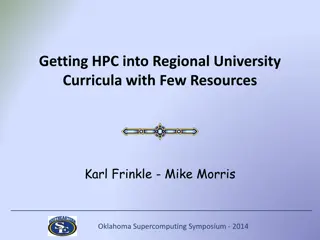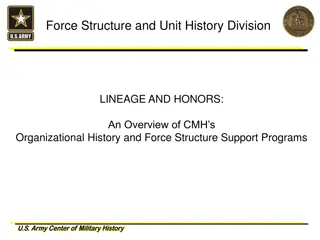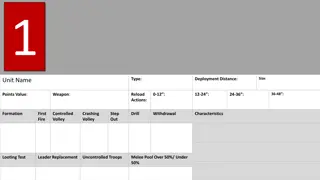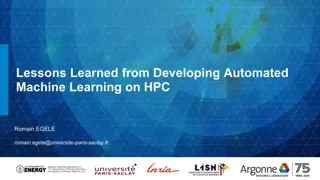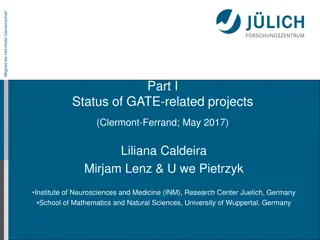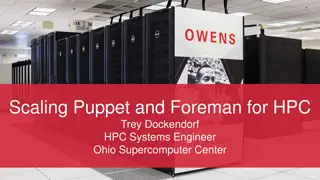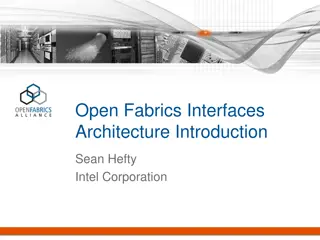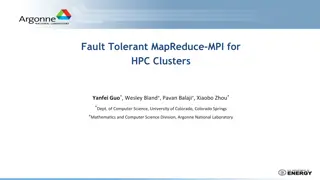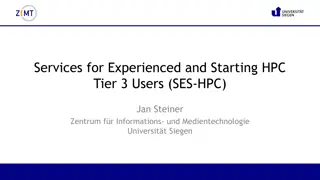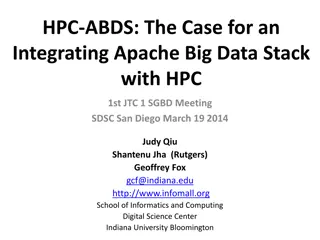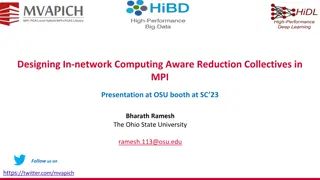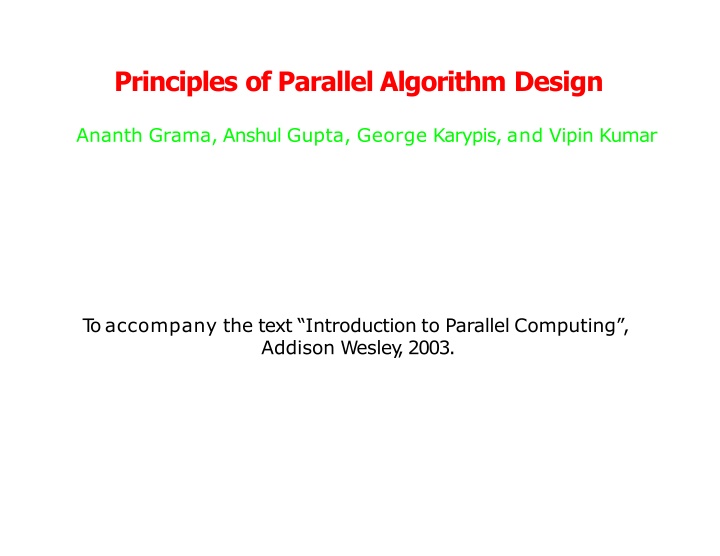
Parallel Algorithm Design: Principles, Models, and Techniques
Explore the principles and models of parallel algorithm design, including decomposition techniques, complexities, and interactions. Learn about parallel algorithm recipes, steps for constructing efficient algorithms, and the importance of concurrency in solving problems using multiple processors.
Download Presentation

Please find below an Image/Link to download the presentation.
The content on the website is provided AS IS for your information and personal use only. It may not be sold, licensed, or shared on other websites without obtaining consent from the author. If you encounter any issues during the download, it is possible that the publisher has removed the file from their server.
You are allowed to download the files provided on this website for personal or commercial use, subject to the condition that they are used lawfully. All files are the property of their respective owners.
The content on the website is provided AS IS for your information and personal use only. It may not be sold, licensed, or shared on other websites without obtaining consent from the author.
E N D
Presentation Transcript
Principles of Parallel Algorithm Design Ananth Grama, Anshul Gupta, George Karypis, and Vipin Kumar T oaccompany the text Introduction to Parallel Computing , Addison Wesley , 2003.
Unit 2: Parallel Algorithm Design Syllabus: Principles of Parallel Algorithm Design: Preliminaries, Decomposition Techniques, Characteristics of Tasks and Interactions, Mapping Techniques for Load Balancing, Methods for Containing Interaction overheads Parallel Algorithm Models: Data, Task, Work Pool and Master Slave Model Complexities: Sequential and Parallel Computational Complexity, Anomalies in Parallel Algorithms.
Course Object- Outcome Mapping Course Objectives: To analyze the performance and modeling of parallel programs Course Outcomes: CO2: Design and Develop an efficient parallel algorithm to solve given problem
Parallel Algorithm Recipe to solve a problem using multiple processors Typical steps for constructing a parallel algorithm identify what pieces of work can be performed concurrently partition and map work onto independent processors distribute a program s input, output, and intermediate data coordinate accesses to shared data: avoid conflicts ensure proper order of work using synchronization Why typical ? Some of the steps may be omitted. if data is in shared memory, distributing it may be unnecessary if using message passing, there may not be shared data the mapping of work to processors can be done statically by the programmer or dynamically by the runtime 4
Chapter Overview: Algorithms and Concurrency Introduction to Parallel Algorithms T asks and Decomposition Processes and Mapping Processes VersusProcessors Decomposition Techniques Recursive Decomposition Recursive Decomposition Exploratory Decomposition Hybrid Decomposition Characteristics of T asksand Interactions T ask Generation, Granularity ,and Context Characteristics of T ask Interactions.
Chapter Overview: Concurrency and Mapping Mapping T echniques for Load Balancing Static and Dynamic Mapping Methods for Minimizing Interaction Overheads Maximizing Data Locality Minimizing Contention and Hot-Spots Overlapping Communication and Computations Replication vs. Communication Group Communications vs. Point-to-Point Communication Parallel Algorithm Design Models Data-Parallel, Work-Pool, T ask Graph, Master-Slave, Pipeline, and Hybrid Models
Preliminaries: Decomposition, T asks, and Dependency Graphs Thefirststep indeveloping a parallel algorithm isto decompose the problem into tasks that can be executed concurrently A given problem may be docomposed into tasks in many different ways. T asksmay be of same, different, or even interminate sizes. A decomposition can be illustrated in the form of a directed graph with nodes corresponding to tasks and edges indicating that the result of one task is required for processing the next. Such a graph iscalled a task dependency graph.
Example: Multiplying a Dense Matrix with a Vector A b y n 0 1 Task1 2 n-1 Taskn Computation of each element of output vector y is independent of other elements. Based on this, a dense matrix-vector product can be decomposed into n tasks. The figure highlights the portion of the matrix and vector accessed by T ask1. Observations: While tasks share data (namely, the vector b), they do not have any control dependencies i.e., no task needs to wait for the (partial) completion of any other. All tasks are of the same size in terms of number of operations. Is this the maximum number of tasks we could decompose this problem into?
Example: Database Query Processing Consider the execution of the query: MODEL (COLOR AND YEAR = OR COLOR = CIVIC = GREEN 2001 AND = WHITE) on the following database: ID# 4523 3476 7623 9834 6734 5342 3845 8354 4395 7352 Model Civic Corolla Camry Prius Civic Altima Maxima Accord Civic Civic Year 2002 1999 2001 2001 2001 2001 2001 2000 2001 2002 Color Blue White Green Green White Green Blue Green Red Red Dealer MN IL NY CA OR FL NY VT CA WA Price $18,000 $15,000 $21,000 $18,000 $17,000 $19,000 $22,000 $18,000 $17,000 $18,000
Example: Database Query Processing The execution of the query can be divided into subtasks in various ways. Each task can be thought of as generating an intermediate table of entries that satisfy a particular clause. ID# Year ID# Model ID# Color 7623 6734 5342 3845 4395 2001 2001 2001 2001 2001 4523 6734 4395 7352 Civic Civic Civic Civic 7623 9834 5342 8354 Green Green Green Green ID# Color 3476 6734 White White Civic 2001 White Green ID# Color 3476 7623 9834 6734 5342 8354 White Green Green White Green Green ID# Model Year Civic AND 2001 WhiteOR Green 6734 4395 Civic Civic 2001 2001 Civic AND 2001 AND (White OR Green) ID# Model Year Color 6734 Civic 2001 White Decomposing the given query into a number of tasks. Edges in this graph denote that the output of one task isneeded to accomplish the next.
Example: Database Query Processing Note that the same problem can be decomposed into subtasks in other ways as well. ID# Year ID# Color ID# Model 7623 6734 5342 3845 4395 2001 2001 2001 2001 2001 7623 9834 5342 8354 Green Green Green Green 4523 6734 4395 7352 Civic Civic Civic Civic ID# Color 3476 6734 White White Civic 2001 White Green ID# Color 3476 7623 9834 6734 5342 8354 White Green Green White Green Green White OR Green ID# Color Year 2001 AND (White or Green) 7623 6734 5342 Green White Green 2001 2001 2001 Civic AND 2001 AND (White OR Green) ID# Model Year Color 6734 Civic 2001 White An alternate decomposition of the given problem into subtasks, along with their data dependencies. Different task decompositions may lead to significant differences with respect to their eventual parallel performance.
Granularityof T ask Decompositions The number of tasks into which a problem is decomposed determines itsgranularity . Decomposition into a large number of tasks results in fine- grained decomposition and that into a small number of tasks results in a coarse grained decomposition. A b y n 0 1 ... Task 1 Task 2 Task 3 Task 4 A coarse grained counterpart to the dense matrix-vector product example. Each task in this example corresponds to the computation of three elements of the result vector .
Degree of Concurrency The number of tasks that can be executed in parallel is the degree of concurrency of a decomposition. Since the number of tasks that can be executed in parallel may change over program execution, the maximum degree of concurrency is the maximum number of such tasks at any point during execution. What is the maximum degree of concurrency of the database query examples? The average degree of concurrency is the average number of tasks that can be processed in parallel over the execution of the program. Assuming that each tasks in the database example takes identical processing time, what is the average degree of concurrency in each decomposition? The degree of concurrency increases as the decomposition becomes finer in granularity and vice versa.
Critical Path Length A directed path in the task dependency graph represents a sequence of tasks that must be processed one after the other. Thelongest such path determines the shortesttime inwhich the program can be executed in parallel. The length of the longest path in a task dependency graph is called the critical path length.
Critical Path Length Consider the task dependency graphs of the two database query decompositions: Task 4 Task 3 Task 2 Task 1 Task 4 Task 3 Task 2 Task 1 10 10 10 10 10 10 10 10 6 Task 5 9 Task 6 6 Task 5 11 Task 6 8 Task 7 7 Task 7 (a) (b) What are the critical path lengths for the two task dependency graphs? If each task takes 10 time units, what is the shortest parallel execution time for each decomposition? How many processors are needed in each case to achieve this minimum parallel execution time? What is the maximum degree of concurrency?
Limitson Parallel Performance It would appear that the parallel time can be made arbitrarily small by making the decomposition finer in granularity. There is an inherent bound on how fine the granularity of a computation can be. For example, in the case of multiplying a dense matrix with a vector, there can be no more than (n2) concurrent tasks. Concurrent tasks may also have to exchange data with other tasks. This results in communication overhead. The tradeoff between the granularity of a decomposition and associated overheads often determines performance bounds.
Amdahls Law A hard limit on the speedup that can be obtained using multiple CPUs Two expressions of Amdahl s law execution time on N CPUs speedup on N processors https://en.wikipedia.org/wiki/Amdahl's_law 17
Amdahls Law https://en.wikipedia.org/wiki/Amdahl's_law 18
T ask Interaction Graphs Subtasksgenerallyexchange data withothersina decomposition. For example, even in the trivial decomposition of the dense matrix-vector product, if the vector isnot replicated across all tasks,they will have to communicate elements of the vector. The graph exchange (edges) isreferred to as a task interaction graph. of tasks (nodes) and their interactions/data Note that task interaction graphs represent data dependencies, whereastask dependency graphs represent control dependencies.
Task Interaction Graph Example Sparse matrix-vector multiplication Computation of each result element = independent task Only non-zero elements of sparse matrix A participate If, b is partitioned among tasks structure of the task interaction graph = graph of the matrix A (i.e. the graph for which A represents the adjacency structure) 20
Interaction Graphs, Granularity, & Communication Finer task granularity increases communication overhead Example: sparse matrix-vector product interaction graph Assumptions: each node takes unit time to process each interaction (edge) causes an overhead of a unit time If node 0 is a task: communication = 3; computation = 4 If nodes 0, 4, and 5 are a task: communication = 5; computation = 15 coarser-grain decomposition smaller communication/computation21
Processes and Mapping In general, the number of tasks in a decomposition exceeds the number of processing elements available. For this reason, a parallel algorithm must also provide a mapping of tasks to processes. Note: We refer to the mapping as being from tasks to processes, as opposed to processors. This is because typical programming APIs, as we shall see, do not allow easy binding of tasks to physical processors. Rather, we aggregate tasks into processes and rely on the system to map these processes to physical processors. We use processes, not in the UNIX sense of a process, rather, simply as a collection of tasks and associated data.
Processes and Mapping Appropriate mapping of tasks to processes is critical to the parallel performance of an algorithm. Mappings are determined by both the task dependency and task interaction graphs. T ask dependency graphs can be used to ensure that work is equally spread across all processes at any point (minimum idling and optimal load balance). T ask interaction graphs can be used to make sure that processes need minimum interaction with other processes (minimum communication).
Processes and Mapping An appropriate mapping must minimize parallel execution time by: Mapping independent tasks to different processes. Assigning tasks on critical path to processes as soon as they become available. Minimizing interaction between processes by mapping tasks with dense interactions to the same process. Note: These criteria often conflict eith each other. For example, a decomposition into one task (or no decomposition at all) minimizes interaction but does not result in a speedup at all! Can you think of other such conflicting cases?
Processes and Mapping: Example Task 4 Task 3 Task 2 Task 1 Task 4 Task 3 Task 2 Task 1 10 10 10 10 10 10 10 10 P1 P1 P3 P2 P0 P0 P3 P2 P0 6 Task 5 P0 P2 9 Task 6 6 Task 5 P0 11 Task 6 P0 P0 8 Task 7 7 Task 7 (a) (b) Mapping tasks in the database query decomposition to processes. These mappings were arrived at by viewing the dependency graph in terms of levels (no two nodes in a level have dependencies). T askswithin a single level are then assigned to different processes.
Decomposition Techniques So how does one decompose a task into various subtasks? While there is no single recipe that works for all problems, we present a set of commonly used techniques that apply to broad classes of problems. These include: recursive decomposition data decomposition exploratory decomposition speculative decomposition
Recursive Decomposition Generally suited to problems that are solved using the divide- and-conquer strategy. A given problem isfirstdecomposed into a setof sub-problems. These sub-problems are recursively decomposed further until a desired granularityisreached.
Recursive Decomposition: Example A classic example of a divide-and-conquer algorithm on which we can apply recursive decomposition isQuicksort. 5 12 11 1 10 6 8 3 7 4 9 2 1 3 4 2 5 12 11 10 6 8 7 9 5 6 8 7 9 12 11 10 1 2 3 4 10 12 11 5 6 7 8 1 2 3 4 9 11 12 5 6 7 8 10 11 12 In this example, once the list has been partitioned around each sublist can be processed concurrently (i.e., each sublist represents an independent subtask). Thiscan be repeated recursively . the pivot,
Recursive Decomposition: Example The problem of finding the minimum number in a given list (or indeed any other associative operation such as sum, AND, etc.) can be fashioned as a divide-and-conquer algorithm. The following algorithm illustrates this. We first start with a simple serial loop for computing the minimum entry in a given list: procedure SERIAL MIN (A, n) begin min =A[0]; for i := 1 to n 1 do 1. 2. 3. 4. 5. 6. 7. 8. if(A[i]< min)min :=A[i]; endfor; return min; end SERIAL MIN
Recursive Decomposition: Example We can rewrite the loop as follows: procedure RECURSIVE MIN (A, n) begin if(n = 1)then min :=A[0]; else lmin :=RECURSIVE MIN (A, n/2); rmin :=RECURSIVE MIN (&(A[n/2]),n n/2); if (lmin < rmin) then min :=lmin; else min :=rmin; endelse; 1. 2. 3. 4. 5. 6. 7. 8. 9. 10. 11. 12. 13. endelse; 14. return min; 15. end RECURSIVE MIN
Recursive Decomposition: Example The code in the previous foil can be decomposed naturally using a recursive decomposition strategy. We illustrate this with the following example of finding the minimum number in the set {4, 9, 1, 7, 8, 11, 2, 12}. The task dependency graph associated with this computation isas follows: min(1,2) min(4,1) min(8,2) min(4,9) min(1,7) min(8,11) min(2,12)
Data Decomposition Identify the data on which computations are performed. Partition this data acrossvarious tasks. Thispartitioning induces a decomposition of the problem. Data can be partitioned in various ways this critically impacts performance of a parallel algorithm.
Data Decomposition: Output Data Decomposition Often, each element of the output can be computed independently of others (but simply as a function of the input). A partition of the output across tasksdecomposes the problem naturally.
Output Data Decomposition: Example Consider the problem of multiplying two n n matrices A and B to yield matrix C. The output matrix C can be partitioned into four tasks as follows: A A2,1 B B2,1 C C2,1 . T ask 1: C1,1= A1,1B1,1+ A1,2B2,1 T ask 2: C1,2 = A1,1B1,2+ A1,2B2,2 T ask 3: C2,1 = A2,1B1,1+ A2,2B2,1 T ask 4: C2,2= A2,1B1,2+ A2,2B2,2
Output Data Decomposition: Example A partitioning of output data does not result in a unique decomposition into tasks. For example, for the same problem as in previus foil, with identical output data distribution, we can derive the following two (other) decompositions: Decomposition I Decomposition II Task 1:C1,1= A1,1B1,1 Task 2:C1,1 = C1,1+ A1,2B2,1 Task 3:C1,2= A1,1B1,2 Task 4:C1,2 = C1,2+ A1,2B2,2 Task 5:C2,1= A2,1B1,1 Task 6:C2,1 = C2,1+ A2,2B2,1 Task 7:C2,2= A2,1B1,2 Task 8: C2,2 = C2,2+ A2,2B2,2 Task 1:C1,1= A1,1B1,1 Task 2:C1,1 = C1,1+ A1,2B2,1 Task 3:C1,2= A1,2B2,2 Task 4:C1,2 = C1,2+ A1,1B1,2 Task 5:C2,1= A2,2B2,1 Task 6:C2,1 = C2,1+ A2,1B1,1 Task 7:C2,2= A2,1B1,2 Task 8: C2,2 = C2,2+ A2,2B2,2
Output Data Decomposition: Example Consider the problem of counting the instances of given itemsets in a database of transactions. In this case, the output (itemset frequencies) can be partitioned across tasks. (a) Transactions (input), itemsets (input), and frequencies (output) A, B, C A, B, C, E, G, H B, D, E, F, K, L 1 D, E 3 0 Itemset Frequency Database Transactions A, B, F, H, L C, F, G Itemsets A, E D, E, F, H F, G, H, K, 2 1 C, D A, E, F, K, L D, K 2 B, C, F B, C, D, G, H, L 0 C, D, K G, H, L D, E, F, K, L 0 F, G, H, L (b) Partitioning the frequencies (and itemsets) among the tasks 1 1 Itemset Frequency Itemset Frequency A, B, C C, D A, B, C, E, G, H B, D, E, F, K, L A, B, C, E, G, H B, D, E, F, K, L Itemsets Itemsets 2 3 0 D, E D, K 0 Database Transactions Database Transactions A, B, F, H, L C, F, G A, B, F, H, L B, C, F 2 0 A, E C, D, K D, E, F, H F, G, H, K, D, E, F, H F, G, H, K, A, E, F, K, L A, E, F, K, L B, C, D, G, H, L B, C, D, G, H, L G, H, L D, E, F, K, L G, H, L D, E, F, K, L F, G, H, L F, G, H, L task1 task2
Output Data Decomposition: Example From the previous example, the following observations can be made: If the database of transactions is replicated across the processes, each task can be independently accomplished with no communication. If the database is partitioned across processes as well (for reasons of memory utilization), each task first computes partial counts. These counts are then aggregated at the appropriate task.
InputData Partitioning Generally computed as a function of the input. applicable if each output can be naturally In many cases, this is the only natural decomposition because the output is not clearly known a-priori (e.g., the problem of finding the minimum in a list, sorting a given list, etc.). A task is associated with each input data partition. The task performs as much of the computation with itspart of the data. Subsequent processing combines these partial results.
InputData Partitioning: Example Inthe database counting example, the input (i.e., the transaction set) can be partitioned. This induces a task decomposition in which each task generates partial counts for all itemsets. These are combined subsequently for aggregate counts. Partitioning the transactions among the tasks DatabaseTransactions DatabaseTransactions A, B, C A, B, C 0 A, B, C, E, G, H B, D, E, F, K, L 1 1 D,E C, F, G A,E 2 D,E C, F, G A,E ItemsetFrequency ItemsetFrequency A, B, F, H, L 0 0 Itemsets Itemsets 1 A, E, F, K, L B, C, D, G, H, L 1 D, E, F, H F, G, H, K, C,D C,D 1 0 G, H, L D, E, F, K, L 1 1 D,K B, C, F C, D, K D,K B, C, F C, D, K 0 0 F, G, H, L 0 0 task 1 task 2
Partitioning Inputand Output Data Often input and output data decomposition can be combined for a higher degree of concurrency. For the itemset counting example, the transaction set (input) and itemset counts (output) can both be decomposed as follows: Partitioning both transactions and frequencies among the tasks Database Transactions Database Transactions A, B, C A, B, C, E, G, H B, D, E, F, K, L A, B, C, E, G, H B, D, E, F, K, L 1 D, E 2 Itemset Frequency Itemset Frequency A, B, F, H, L C, F, G A, B, F, H, L 0 Itemsets Itemsets A, E D, E, F, H F, G, H, K, D, E, F, H F, G, H, K, 1 C, D 0 1 D, K B, C, F 0 C, D, K 0 task 1 task 2 Database Transactions Database Transactions A, B, C 0 D, E 1 Itemset Frequency Itemset Frequency C, F, G 0 Itemsets Itemsets A, E A, E, F, K, L A, E, F, K, L 1 C, D B, C, D, G, H, L B, C, D, G, H, L 1 G, H, L D, E, F, K, L G, H, L D, E, F, K, L 1 D, K B, C, F 0 C, D, K F, G, H, L F, G, H, L 0 task 4 task 3
Intermediate Data Partitioning Computation can transformation from the input to the output data. often be viewed as a sequence of In these cases, it is often beneficial to use one of the intermediate stages as a basis for decomposition.
Intermediate Data Partitioning: Example Let us revisit the example of dense matrix multiplication. We first show how we can visualize this computation in terms of intermediate matrices D. . A1,1 B1,1 B1,2 D1,1,2 D1,1,1 A2,1 D1,2,1 D1,2,2 + . A1,2 D2,1,1 D2,1,2 A2,2 B2,1 B2,2 D2,2,1 D2,2,2 C1,1 C1,2 C2,1 C2,2
Intermediate Data Partitioning: Example A decomposition of intermediate data structure D decomposition into 8+4 tasks: leads to the following Stage I 1 0 D D D2,1,1 D2,2,2 D1,1,2 D1,2,2 D2,1,2 D2,2,2 1,1,1 1,2,2 B@ C A1,1 A2,1 A1,2 A2,2 B1,1 B2,1 B1,2 B2,2 A . Stage II C1,2 C2,2 D1,1,1 D1,2,2 D2,1,1 D2,2,2 C C2,1 D1,1,2 D1,2,2 D2,1,2 D2,2,2 1,1 + D1,1,1 = A1,1B1,1 D1,1,2 = A1,1B1,2 D1,2,1 = A2,1B1,1 D1,2,2 = A2,1B1,2 C1,1 = D1,1,1 + D2,1,1 C2,1 = D1,2,1 + D2,2,1 D2,1,1 = A1,2B2,1 D2,1,2 = A1,2B2,2 D2,2,1 = A2,2B2,1 D2,2,2 = A2,2B2,2 C1,2 = D1,1,2 + D2,1,2 C2,2 = D1,2,2 + D2,2,2 Task 01: Task 03: Task 05: Task 07: Task 09: Task 11: Task 02: Task 04: Task 06: Task 08: Task 10: Task 12:
Intermediate Data Partitioning: Example The task dependency graph for the decomposition (shown in previous foil) into 12 tasks isas follows: 1 2 3 4 5 6 7 8 9 10 11 12
The Owner Computes Rule The Owner Computes Rule generally states that the process assined a particular data item isresponsible forall computation associated with it. Inthe case of input data decomposition, the owner computes rule imples that all computations that use the input data are performed by the process. In the case of output data decomposition, the owner computes rule implies that the output is computed by the process to which the output data isassigned.
Exploratory Decomposition Inmany cases, the decomposition of the problem goes hand- in-hand with itsexecution. These problems typically involve the exploration (search) of a state space of solutions. Problems in this class include a variety of discrete optimization problems (0/1 integer programming, QAP, etc.), theorem proving, game playing, etc.
Exploratory Decomposition: Example A simple application of exploratory decomposition is in the solution to a 15 puzzle (a tile puzzle). We show a sequence of three moves that transform a given initial state (a) to desired final state (d). 1 2 3 4 1 2 3 4 1 2 3 4 1 2 3 4 5 6 8 5 6 7 8 5 6 7 8 5 6 7 8 9 10 7 11 9 10 11 9 10 11 9 10 11 12 13 14 15 12 13 14 15 12 13 14 15 12 13 14 15 (a) (b) (c) (d) Of-course, the problem of computing the solution, in general, ismuch more difficult than in this simple example.
Exploratory Decomposition: Example Thestatespace can be explored by generating various successor statesof the currentstateand to view them asindependent tasks. 13 14 15 12 9 5 1 10 6 2 7 3 11 8 4 task 1 task 2 task 3 task 4 13 14 13 14 15 12 13 14 15 12 13 14 15 12 9 5 1 9 5 1 9 5 1 9 5 1 10 15 11 10 10 11 6 7 8 2 3 4 6 2 6 7 2 3 6 2 10 11 7 8 3 4 7 3 12 11 8 4 8 4 13 14 15 12 13 13 14 12 13 14 15 12 13 14 15 12 13 14 15 12 13 14 15 12 13 13 14 15 12 13 14 15 12 13 14 15 12 13 14 15 13 14 15 12 13 14 15 12 9 5 1 9 5 1 9 5 1 9 5 1 9 5 1 9 5 1 9 5 1 9 5 1 9 5 1 9 5 1 9 5 1 9 5 1 9 5 1 5 6 1 2 10 10 15 11 10 10 10 10 10 10 11 12 10 11 8 10 10 15 11 14 10 11 6 2 6 7 8 2 3 4 6 2 6 2 6 2 6 2 6 7 8 2 3 4 6 7 2 3 4 6 2 2 6 2 9 6 7 8 2 3 4 6 7 8 2 3 4 10 11 10 11 14 12 15 12 7 8 3 4 7 8 3 4 7 3 7 3 7 6 3 7 11 8 3 4 7 3 7 3 3 8 7 11 11 11 11 11 11 8 4 8 4 8 4 8 4 8 4 4
Exploratory Decomposition: Anomalous Computations Inmany instances of exploratorydecomposition, the decomposition technique may change the amount of work done by the parallel formulation. Thischange results in super -or sub-linear speedups. m m m m m m m m Solution Total serial work: 2m+1 Total parallel work: 1 Total serial work: m Total parallel work: 4m (a) (b)
Speculative Decomposition In some applications, dependencies between tasks are not known a-priori. For such applications, it is impossible to identify independent tasks. There are such applications: conservative approaches, which identify independent tasksonly when they are guaranteed to not have dependencies, and, optimistic approaches, which schedule tasks even when they may potentially be erroneous. generally two approaches to dealing with Conservative approaches may yield little concurrency and optimistic approaches may require roll-back mechanism in the case of an error .



